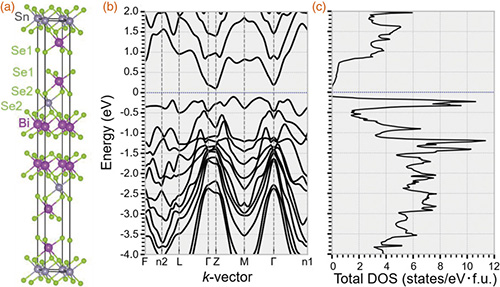- Home
- > Research
- > Research Highlights
- > Vol. 46 New Material That is Both a Th・・・
 Research Highlights
Research Highlights
[Vol. 46]
New Material That is Both a Thermoelectric and a Superconductor Identified by High-Throughput Materials Discovery

Researchers used materials discovery methods to identify and synthesize a material that has thermoelectric properties and, under pressure, is a superconductor.
Data-driven materials science aims at mining information contained in databases collecting the properties of existing materials to identify entirely new compounds with desired properties. This approach is proving successful, but its application is not straightforward for certain classes of materials, such as thermoelectrics — materials that convert temperature differences into electricity and thus hold promise for energy applications — or superconductors, which can transport currents without dissipation and could be used for power transmission.
Yoshihiko Takano and Ryo Matsumoto from the WPI-MANA, NIMS in Tsukuba, Japan, and colleagues used a specific criterion to identify candidate thermoelectric and superconducting materials with high-throughput calculations. Specifically, they looked for materials that in the electronic band structure have bands that are flat near the Fermi level, which separates the occupied and unoccupied electronic states. Indeed, flat bands near the Fermi level are predicted to enhance the thermoelectric properties of materials, and if the flat band crosses the fermi level a superconducting state is realized.
The authors used the screening to identify 45 materials with the desired properties at ambient pressure. They then calculated their properties at high pressure, and pinned down 27 materials that acquire further functionalities when pressure is applied, and finally identified SnBi2Se4 as a candidate material that should display both thermoelectric and superconducting properties. First-principle calculations predict that the material has a flat band that is close to the Fermi level at ambient pressure, but crosses it at a pressure of ~10 GPa, inducing a metal–insulator and then a superconducting transition.
Single-crystal samples of the material were synthesized and measured, and the predicted thermoelectric properties at ambient pressure were verified. To measure the properties of the sample under pressure, the researchers used an especially devised system that allowed them to observe the predicted metal–insulator transition, which was followed by a superconducting phase transition with a critical temperature — the temperature below which the sample is superconducting— of ~2K. Because the critical temperature increased with the application of further pressure, reaching a maximum of ~6K, the authors concluded that the sample underwent a second superconducting phase transition. The thermoelectric properties should be enhanced under pressure, but the experimental tools to perform this measurement are still lacking, thus this aspect will require further investigation. “The present work will serve as a case study of the important first step for next-generation data-driven material science,” comment the authors.
Reference
"Two pressure-induced superconducting transitions in SnBi2Se4 explored by data-driven materials search: new approach to developing novel functional materials including thermoelectric and superconducting materials"
Ryo Matsumoto, Zhufeng Hou, Hiroshi Hara, Shintaro Adachi, Hiroyuki Takeya, Tetsuo Irifune, Kiyoyuki Terakura and Yoshihiko Takano
Journal : Appl. Phys. Express, 11, 093101 (2018).
DOI : 10.7567/APEX.11.093101
Ryo Matsumoto, Zhufeng Hou, Hiroshi Hara, Shintaro Adachi, Hiroyuki Takeya, Tetsuo Irifune, Kiyoyuki Terakura and Yoshihiko Takano
Journal : Appl. Phys. Express, 11, 093101 (2018).
DOI : 10.7567/APEX.11.093101
Affiliations
International Center for Materials Nanoarchitectonics (WPI-MANA), National Institute for Materials Science (NIMS), Namiki 1-1, Tsukuba, Ibaraki 305-0044, Japan
Contact information
Research Center for Materials Nanoarchitectonics (MANA)
National Institute for Materials Science
1-1 Namiki, Tsukuba, Ibaraki 305-0044 Japan
Phone: +81-29-860-4710
E-mail: mana-pr[AT]nims.go.jp
1-1 Namiki, Tsukuba, Ibaraki 305-0044 Japan
Phone: +81-29-860-4710
E-mail: mana-pr[AT]nims.go.jp

